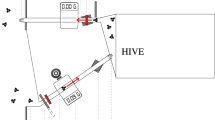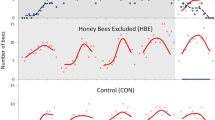Summary
The purpose is to examine the relationships between several aspects of the honey bee's round dance and the caloric costs and gains and net gains per time experienced by bees while foraging between two artificial flowers. The distance between the two flowers and the concentration of nectar rewards were varied. Nine bees were tested, each over several days. Of the three dance variables examined, the number of reversals in the dance per minute (RATE) most often gave the highest and consistently signed correlation coefficients when paired with the mean caloric reward received per flower visit (CALGAIN), the net caloric gain per unit time (NET), and the mean caloric cost to fly to and visit a flower (CALCOST). In general, RATE is positively correlated with CALGAIN (range of positive coefficients, 0.12 to 0.50) and NET (range, 0.15 to 0.40) and negatively correlated with CALCOST (range, −0.01 to −0.28). Additionally, the probability of dancing after foraging is generally positively associated with CALGAIN and negatively associated with CALCOST. The results suggest that caloric gains and costs may be integrated by the bee and output as a measure of “profitability” in the form of the round dance. This information may be communicated to potential recruits, although this is not demonstrated.
Similar content being viewed by others
References
Charnov E (1976) Optimal foraging: attack strategy of a mantid. Am Nat 110:141–151
Frisch K von (1967) The dance language and orientation of bees. Balknap Press, Cambridge, Massachusetts
Gould J (1976) The dance language controversy. Q Rev Biol 51:211–244
Heinrich B (1975) Energetics of pollination. Annu Rev Ecol Syst 6:139–179
Sokal R, Rohlf F (1969) Biometry. Freeman, San Francisco
Waddington K, Holden L (1979) Optimal foraging: on the flower selection by bees. Am Nat 114:179–196
Waddington K, Rothenbuhler W (1976) Behaviour associated with hairless-black syndrome of adult honeybees. J Apic Res 15:35–41
Wenner A, Wells P, Rohlf F (1967) An analysis of the waggle dance and recruitment in honey bees. Physiol Zool 40:317–344
Author information
Authors and Affiliations
Rights and permissions
About this article
Cite this article
Waddington, K.D. Honey bee foraging profitability and round dance correlates. J. Comp. Physiol. 148, 297–301 (1982). https://doi.org/10.1007/BF00679014
Accepted:
Issue Date:
DOI: https://doi.org/10.1007/BF00679014




